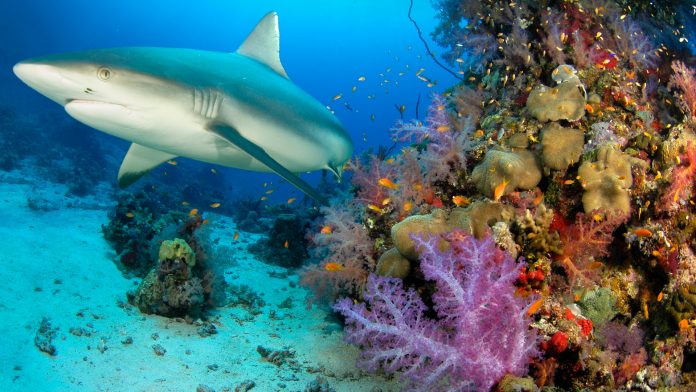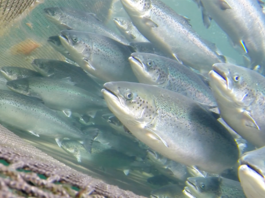According to a new study, shark denticles may provide a coral reef conservation effect, inferring that dwindling numbers in the species may significantly impact ecosystems.
The research, conducted by scientists at the Smithsonian, has revealed that shark denticles – microscopic scales that cover a shark’s body – may not only help them to glide through oceans and offer protection from abrasions, but may potentially help to ensure coral reef conservation, with the discovery of fossilised and modern-day shark denticles found in coral reefs in the Caribbean and Panama.
For over 400 million years, shark-like fishes have thrived and roamed in the oceans; however, now, over 100 million sharks are killed each year by humans, destroying ocean food chains and ecosystems, with this new investigation suggesting that their elimination may greatly impact coral reef conservation.
“If you have ever petted a shark in an aquarium touch tank,” said Erin Dillon, who began this study as an intern at the Smithsonian Tropical Research Institute (STRI) and is now wrapping up her doctoral work at the University of California, Santa Barbara, “denticles are the reason why shark skin is rough like sandpaper if you rub it in one direction yet smooth in the other direction. Sharks are essentially covered by millions of tiny teeth.”
The search for shark denticles
Shark denticles are, essentially, what dandruff is to humans, which once shed collect in the sediments of the ocean, with the oldest discovered denticles found to be around 455 million years old in Colorado’s Harding Sandstone. Aaron O’Dea, an STRI paleobiologist, examined shark denticles from modern coral reefs and fossils to reconstruct the condition before human colonisation, observing how ecological and evolutionary processes evolved over time.
“Placoderms in the Palaeozoic, and then marine reptiles in the Mesozoic, were larger and ate sharks,” O’Dea explained. “Placoderms ruled the oceans for around 70 million years, and marine reptiles of the Mesozoic ruled for more than 100 million years. Sharks are only top predators now because extinction events preferentially took out other groups but allowed sharks to survive. Sharks seem to have remarkable evolutionary resilience, and I was fascinated to work on a technique that would help us explore how sharks have fared more recently when humans step into the picture.”
The researchers examined material from a 7,000-year-old fossilised reef in Bocas del Toro, Panama, and nearby modern Caribbean reefs to see if shark denticles were present in the samples.

“What started as a three-month-long internship turned into a two-year stay in Panama and then expanded into part of my PhD thesis,” Dillon said. “I’ve grown with this project as my role shifted from first exploring and processing the samples as an intern to leading the project, analysing and interpreting the data, and spearheading the writing.”
The team had to filter through over 300 kilograms of reef sediments in a process that took a year of lab work to identify the shark denticles, which they could then use to distinguish which species of sharks were native to Bocas del Toro previously. The team then employed acetic acid to erode the chalky sediments, from which they then isolated the denticles.
Dillon said: “Finding the first denticles was thrilling. They were beautifully preserved and abundant enough to provide insights into millennia-old shark communities.”
Analysing population decline
From their findings, the researchers distinguished that shark denticle accumulation rates – also indicating the population number of sharks – were three times higher before humans started to fish in the region, discovering that all types of denticles declined during this time, most notably the fish species that were most commercially lucrative. Denticles from fast swimming, pelagic sharks – requiem and hammerhead sharks – were identified in the oldest samples, with nurse shark denticles found to be more common today.
Next, the team combined their research with archaeological studies and historical narratives to uncover the reason for these declines, identifying that the harshest decline in the shark population was in the late twentieth century, which was around the period where a pelagic shark targeting fishery was established in the area. Contrastingly, nurse shark denticles have been harvested consistently throughout history, meaning that reductions in prey and habitat may be to blame.
Dillon explained: “When the Spanish arrived in the Americas, they wrote fantastic accounts of seas swarming with sharks. But these days, we see very few sharks: we are lucky to see the occasional nurse shark. Our data shows that sharks in Bocas del Toro have been depleted both by long-term harvesting, which accelerated in the second half of the 20th century and by habitat degradation, which began even earlier with the expansion of banana cultivation and coastal development. There is so much land-based runoff from the coast today that in some locations, it’s like swimming through limeade.”
“Taken together, Erin’s body of work shows that denticle assemblages can be used with care to help reconstruct past shark communities through time,” O’Dea said. “Sharks are an integral part of ocean health and play important roles in the great diversity and functioning of coral reefs. Having empirical estimates of past shark abundances and community composition helps us frame our understanding of what is natural in the seas.”
“We hope to extend this method to other locations to examine broader geographic patterns of change in reef shark communities over long ecological timescales,” Dillon said. “For example, we’re currently reconstructing trends in denticle accumulation along Panama’s Pacific coast over the last several thousand years using sediment cores. These baseline data will help us explore the causes and consequences of changes in shark abundance and functional diversity. Our work can also help tailor shark management goals to this local region.”









